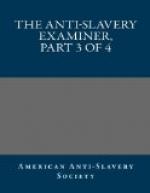“When it rained, the slaves were allowed to collect under a tree until the shower had passed. Seldom, on a week day, were they permitted to go to their huts during rain; and even had this privilege been granted, many of those miserable habitations were in so dilapidated a condition, that they would afford little or no protection. Negro huts are built of logs, covered with boards or thatch, having no flooring, and but one apartment, serving all the purposes of sleeping, cooking, &c. Some are furnished with a temporary loft. I have seen a whole family herded together in a loft ten feet by twelve. In cold weather, they gather around the fire, spread their blankets on the ground, and keep as comfortable as they can. Their supply of clothing is scanty—each slave being allowed a Holland coat and pantaloons, of the coarsest manufacture, and one pair of cowhide shoes. The women, enough of the same kind of cloth for one frock. They have also one pair of shoes. Shoes are given to the slaves in the winter only. In summer, their clothing is composed of osnaburgs. Slaves on different plantations are not allowed without a written permission, to visit their fellow bondsmen, under penalty of severe chastisement. I witnessed the chastisement of a young male slave, who was found lurking about the plantation, and could give no other account of himself, than that he wanted to visit some of his acquaintance. Fifty lashes was the penalty for this offence. I could not endure the dreadful shrieks of the tortured slave, and rushed away front the scene.”
The remainder of this testimony is furnished by Mr. F.C. Macy.
“I went to Savannah in 1820. Sailing up the river, I had my first view of slavery. A large number of men and women, with a piece of board on their heads, carrying mud, for the purpose of dyking, near the river. After tarrying a while in Savannah, I went down to the sea islands of De Fuskee and Hilton Head, where I spent six months. Negro houses are small, built of rough materials, and no floor. Their clothing, (one suit,) coarse; which they received on Christmas day. Their food was three pecks of potatoes per week, in the potatoe season, and one peck of corn the remainder of the year. The slaves carried with them into the field their meal, and a gourd of water. They cooked their hommony in the field, and ate it with a wooden paddle. Their treatment was little better than that of brutes. Whipping was nearly an every-day practice. On Mr. M——’s plantation, at the island De Fuskee, I saw an old man whipped; he was about 60. He had no clothing on, except a shirt. The man that inflicted the blows was Flim, a tall and stout man. The whipping was very severe. I inquired into the cause. Some vegetables had been stolen from his master’s garden, of which he could give no account. I saw several women whipped, some of whom were in very delicate circumstances. The case of one I will relate. She had been purchased in Charleston, and separated from her husband. On her passage to Savannah, or rather to the island, she was delivered of a child; and in about three weeks after this, she appeared to be deranged. She would leave her work, go into the woods, and sing. Her master sent for her, and ordered the driver to whip her. I was near enough to hear the strokes.




